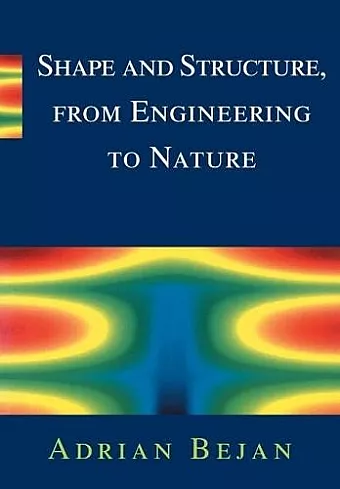Shape and Structure, from Engineering to Nature
Format:Paperback
Publisher:Cambridge University Press
Currently unavailable, and unfortunately no date known when it will be back
This paperback is available in another edition too:
- Hardback£120.00(9780521790499)

This 2000 book explores the similarities between shape and structure in engineered and natural systems.
In this groundbreaking 2000 book, Adrian Bejan shows that shape and structure spring from the struggle for better performance in both engineering and nature and that the same objectives and constraints principle applies. From heat exchangers to river channels, the book draws many parallels between the engineered and the natural world.Seemingly universal geometric forms unite the flow systems of engineering and nature. For example, tree-shaped flows can be seen in computers, lungs, dendritic crystals, urban street patterns, and communication links. In this groundbreaking book, first published in 2000, Adrian Bejan considers the design and optimization of engineered systems and discovers a deterministic principle of the generation of geometric form in natural systems. Shape and structure spring from the struggle for better performance in both engineering and nature. This idea is the basis of the new constructal theory: the objective and constraints principle used in engineering is the same mechanism from which the geometry in natural flow systems emerges. From heat exchangers to river channels, the book draws many parallels between the engineered and the natural world. Among the topics covered are mechanical structure, thermal structure, heat trees, ducts and rivers, turbulent structure, and structure in transportation and economics. The numerous illustrations, examples, and homework problems in every chapter make this an ideal text for engineering design courses. Its provocative ideas will also appeal to a broad range of readers in engineering, natural sciences, economics, and business.
'Shape and Structure is at once fascinating, provocative, mesmerizing, and hazardous to your pedagogical schemes. The book is fascinating because it covers an unusual number of diverse topics; provocative because it advances a new theory whose author unabashedly hints that his law is in the same league as Clausius' second law of thermodynamics, because a simple law is purported to predict the geometric form of anything 'alive' in the universe, or at least on Earth; and hazardous because it is suggested as a text or supplement for design courses in all branches of engineering, architecture, spatial economics, and business.' Applied Mechanical Review
'… this is an outstanding book, highly recommended not only for physicists and engineers, but also for life scientists, physicians, architects, economists and in general, for any person interested in how natural and man-made systems are composed and perform the way they do.' J. Cervantes-de Gortari, International Journal of Heat and Mass Transfer
'Written in a refined style, with lucidity in every aspect that it covers, this delightful read conducts the reader through the marvelous world of optimal systems … In summary, this is an outstanding book, highly recommended not only for physicists and engineers, but also for life scientists, physicians, architects, economists and in general, for any person interested in how natural and man-made systems are composed and perform the way they do. Reading the book is a joyful experience that further stimulates the reader's mind and contributes to the creative observation of our natural and ingenuous world.' J. Cervantes-de Gortari, International Journal of Heat and Mass Transfer
'I wish to attract attention to this unique, path-breaking and thought-provoking book of wide readership …'. International Journal of Applied Thermodynamics
'This is a most unusual and fascinating book … Anyone concerned with optimization, including students taking a course on the subject, will derive inspiration and insight from this book, and anyone with an interest in engineering and nature will get a great deal of pleasure from it.' Peter Bradshaw, AIAA Journal
ISBN: 9780521793889
Dimensions: 255mm x 178mm x 19mm
Weight: 641g
364 pages